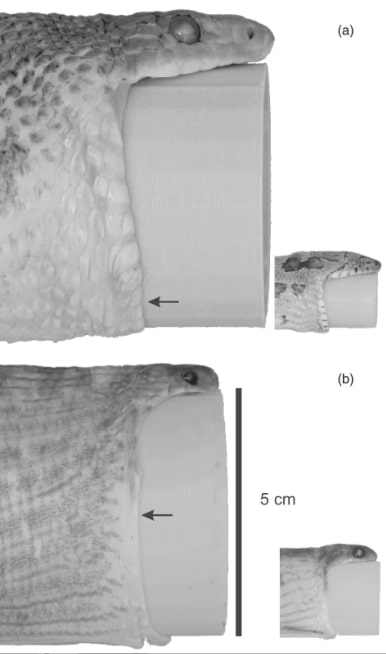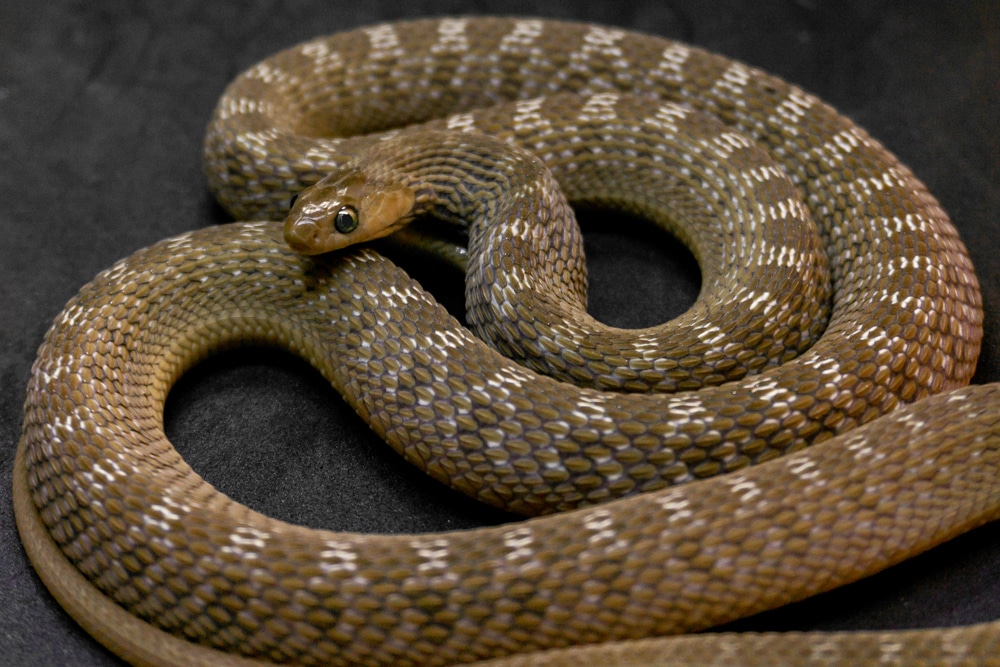Of the 13 snake species with known gape, the Gans' egg-eating snake had the greatest gape. The Burmese python and the western diamondback rattlesnake have the next largest gapes.
The Gans’ egg-eating snake (Dasypeltis gansi), a non-venomous colubrid native to West Africa, is a small snake, with females reaching about 40 inches in length, while males reach about 28 inches in length. But what is impressive is relative to its size, is the gape of its mouth. Thanks to the stretchy skin between its jawbones, the Gans’ egg eating snake can consume prey that is three to four times larger than snakes that are generalists such as the black rat snake (Pantherophis obsoletus), Biologist Bruce Jayne of the University of Cincinnati said in a news item posted to the university’s news website.

Extreme sizes of snakes used to determine maximal gape. (a) Pantherophis obsoletus. The specimens on the left (snout–vent length (SVL) = 150 cm; Gdiam = 5.3 cm) and right (SVL = 27 cm; Gdiam = 1.1 cm) were the largest and second to smallest individuals measured for this species, respectively. (b) Dasypeltis gansi. The specimens on the left (SVL = 94 cm; Gdiam = 5.0 cm) and right (SVL = 21 cm; Gdiam = 1.4 cm) were the largest and smallest individuals measured for this species, respectively. The arrows on the large specimens indicate the distal end of the lower jaw. At maximal gape, the circumferential distance between scales exceeded the width of scales in the neck, whereas the scales at rest completely covered the skin between scales. Photo by Bruce Jayne/University of Cincinnati
Jayne conducted a study on the gape of the Gans’ egg-eating snake and found the snake’s extreme gape enables them to eat bigger eggs for its size. Jayne noted that the snake is a bird egg eating specialist and the capability of this species to swallow larger eggs enables them to consume more calories.
“One likely reason this extreme gape evolved in African egg-eating snakes is that they specialize on a prey shape with a modest amount of mass per cross-sectional area,” Jayne told UC News. “That puts a premium on having a wide mouth.”

Gans’ egg eating snake has the largest mouth gape of any snake, relative to its size. Photo by Backyard/Shutterstock
Jayne’s research shows that of the 13 snake species with known gape, the Gans’ egg-eating snake had the greatest gape. The Burmese python (Python molurus bivittatus) and the western diamondback rattlesnake (Crotalus atrox) have the next largest gapes.
Egg-Eating Snake Species Discovered In Cambodia
The complete study comparing the gape of a black rat snake and the Gans’ egg-eating snake “Scaling relationships of maximal gape and prey size of snakes for an egg-eating specialist (Dasypeltis gansi) and a dietary generalist (Pantherophis obsoletus)” can be read on the Journal of Zoology website.



